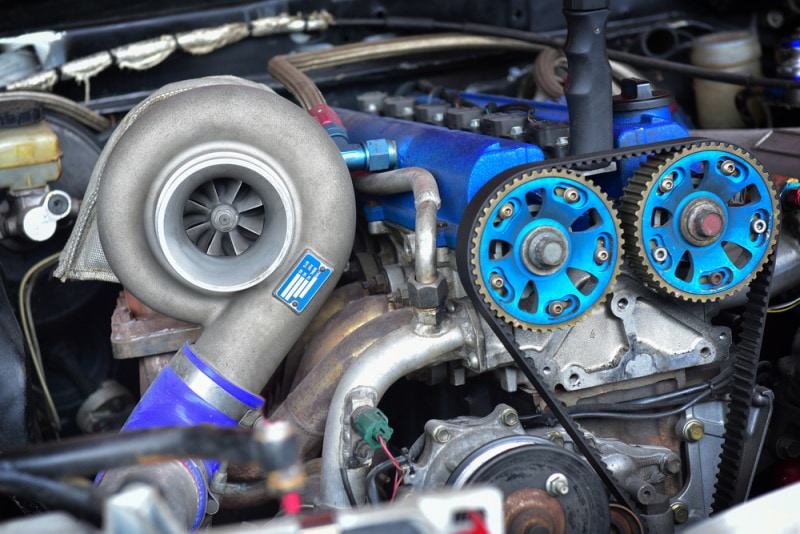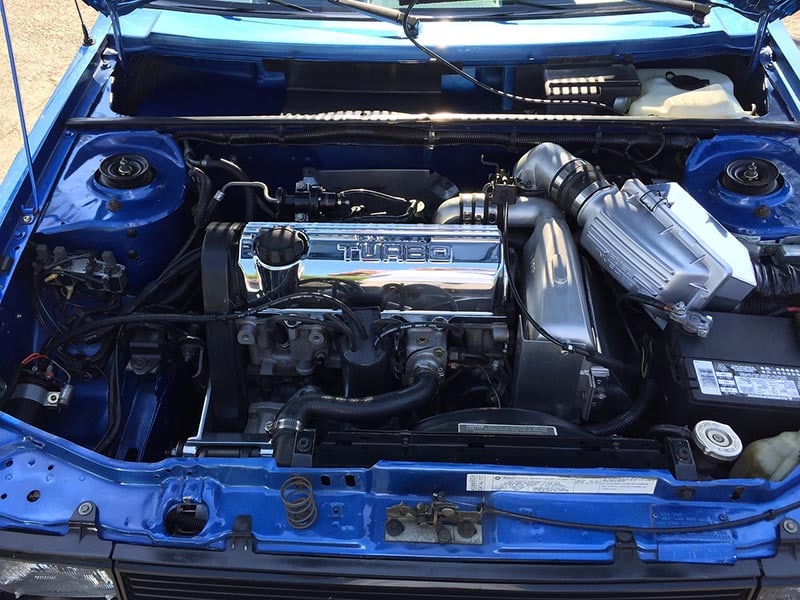How Does a Turbocharger Work? 3 Types
-
Kristin Hitchcock
- Last updated:

A turbocharger works based on some very simple mechanics. Basically, the turbocharger compresses the air flowing into an engine’s cylinders. Therefore, the compressed air creates more fuel for the same-size engine. In this way, drivers can increase the power of an engine without increasing the size of the engine.
While this may sound a bit complicated, the process is rather simple. Let’s take a look at a breakdown of the process.
 How Does It Work?
How Does It Work?

The turbocharger’s job starts with the exhaust manifold. Often, this must be upgraded to handle the increased pressure that a turbocharger provides. Therefore, you can’t just throw a turbo on an engine and expect it to work properly (usually). Doing so can damage the engine. At the very least, the exhaust manifold must usually be changed.
After going through the exhaust manifold, the air flows through the turbine in the turbocharger. The turbo uses heat and pressure from the exhaust to spin the turbine. Often, this wheel is referred to as the “exhaust wheel”. It powers the turbocharger.
There is a shaft that connects the wheel to the compressor wheel. Therefore, when the exhaust wheel spins, the compressor wheel does, too. This process is how the turbocharger gets powered.
Now that the compression shaft is being powered, it pulls air into it. The spinning compressor wheel draws air into the chamber and speeds up the air, creating compression.
And that’s it! A turbocharger is pretty simple despite how it might look. It’s basically just two wheels attached together. One wheel powers the other using the air from the exhaust. The other wheel compresses the air, allowing the engine to go through more air and burn more fuel.
In the end, this leads to more power being produced by an engine without really changing much else. Therefore, turbochargers are often an easy way to increase the amount of power an engine produces.
The 3 Types of Turbo Chargers
1. Single Turbo
This is what most people think of when they hear of a turbocharger. There are several different sizes of a single turbocharger, and the size does matter in terms of the power produced. This type of turbocharger is often the cheapest and most widely available.
2. Twin-Turbo
Basically, cars with twin turbochargers have two turbos in their engine. Usually, this is done by using one of the turbos to work with a single-cylinder bank. However, it can also be done by using one turbo for low RPMs and one turbo for high RPMs.
However, having two turbos significantly increases the cost of the build. Therefore, it isn’t as common in everyday cars.

3. Twin-Scroll Turbo
This turbo divides the cylinders into different scrolls. It works to provide more efficient delivery of air to the turbo, which can improve performance. It also ensures that denser air hits the cylinders, which increases power. However, this is a complex build, as well, increasing the cost substantially.
Advantages of a Turbo
Turbo engines can be outfitted to just about any vehicle (though some may require more work than others, and therefore cost more). A turbo naturally produces more power without increasing the size of the engine. Typically, this is the cheapest way to improve the functioning of an engine.
Sometimes, a turbocharger will provide better fuel economy than getting a bigger engine. However, turbos do cause the engine to use more fuel. With that said, this fuel is burned more cleanly, which may lead to less pollution.
Most turbo engines produce more torque at the lower rev ranges. Therefore, this allows you to accelerate faster. Even if you aren’t racing or driving competitively, this can be a plus.
Often, turbo engines are quieter. Therefore, you may choose a turbo engine just because of the noise difference.
Disadvantages of a Turbo
Many people do not like the noise a turbo engine produces. It isn’t the stereotypical engine noise that people expect. For this reason, it can be a turn-off for some people.
Turbo engines are more expensive than naturally aspirated engines. It is also another part to break down in your engine, which you absolutely have to keep in mind. You may need to do more repairs later on top of paying more upfront for the turbo.
The turbo won’t work at all RPMs, either. There is often a delay as the exhaust pressure builds. Therefore, turbo engines can be a bit more difficult to drive.

Frequently Asked Questions
How Does a Turbo Get Its Power?
A turbo is powered by the airflow of the engine itself. The exhaust air from the engine spins a wheel, which is often called an exhaust wheel. This wheel has a shaft connected to another wheel on the other side of the turbo. Therefore, when the exhaust spins the exhaust wheel, the shaft and other wheel turn, too.
This other wheel is the part that compresses the air and provides extra power to the engine. Therefore, a turbocharger doesn’t need any extra power. It uses the exhaust that the engine is already producing to power itself.
At What Speed Does a Turbo Kick In?
Turbos do not have computers inside of them. Therefore, there isn’t a particular speed that they’re programmed to kick in at. Instead, the turbocharger is powered by the exhaust. Therefore, it cannot work until the exhaust pressure reaches a certain amount. Once the exhaust pressure reaches this amount, the turbo will work.
The exhaust pressure is not directly connected to the speed. It depends on your RPMs—not your speed. Therefore, a turbo may kick in when you’re going 20 mph. However, it may not kick in for someone else who is going 60 mph.
It all depends on your RPMs. Therefore, there is no reason to try and hit a minimum speed to get your turbo to kick in. The speed doesn’t matter.

Can a Turbo Engine Run without the Turbo?
If your engine has a turbo in it that isn’t working, it will still run. However, it will perform poorly, as the turbo is elongating the time it takes the air to move without any benefit. Without the compression of the turbo, the elongated pathway for the air will make your engine run worse.
Furthermore, a failed turbo can indicate a bigger problem. In some cases, it may be a sign that more parts of your engine are about to fail. In this case, you may end up with an engine that doesn’t work shortly.
Conclusion
Turbochargers increase the amount of power an engine produces by increasing the amount of air the engine gets. It does this in a simple manner by compressing the incoming air. Turbochargers are powered by the exhaust of the engine, so they don’t require electricity. However, this does mean that there is a lag for the turbo to start working, which can lead to driving difficulties if you aren’t used to it.
Often, turbos are the cheapest way to increase a car’s power. They can help your car go faster without upgrading the whole engine.
Featured Image Credit: Sanit Fuangnakhon, Shutterstock
Contents
 How Does It Work?
How Does It Work?